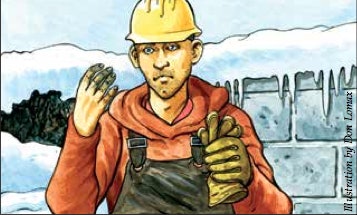
What the expert says: Brisk winds and wet clothing significantly increase your risk of suffering frostbite or hypothermia, cautions Dr. Karen Mulloy, director of Denver Health’s Center for Occupational Safety and Health. There’s little danger of exposed flesh freezing at 10 degrees if wind speed is less than 5 mph, but once it reaches 20 mph, exposed flesh can freeze within 1 minute.
Mulloy notes a light flag moves in a 5-mph wind and fully extends in a 10-mph wind; newspaper lifts off the ground in a 15-mph wind; and a 20-mph wind blows accumulated snow.
Wear several layers of clothing. Put a synthetic fiber such as polypropylene next to your skin because it wicks away sweat. Cover that with wool or cotton, then fleece, then a wind- and water-repellant layer. Wear a hat or hood, two pairs of socks, and cover your ears. Wear wool gloves – and water-proof ones if your hands are likely to get wet. If water gets on your body, change into dry clothes immediately.
Using the buddy system, watch for signs of hypothermia or frostbite. Hypothermia occurs when the body fails to keep its core temperature above 95 degrees Fahrenheit. Symptoms include shivering, blue lips, poor coordination, and confusion. A person experiencing symptoms should go to a warm place, drink something warm, and move their arms and legs to create muscle heat. If symptoms progress beyond shivering and blue lips, call 911.
Frostbite is freezing in deep layers of skin or tissue and usually occurs in the fingers, hands, toes, feet, ears, and nose. Tingling sensations, waxy-white skin color, and hard, numb skin are warning signs. Since tissue needs to be warmed gradually, seek medical attention. Pouring warm water on the tissue or warming it too fast will cause damage, as will rubbing the skin.






